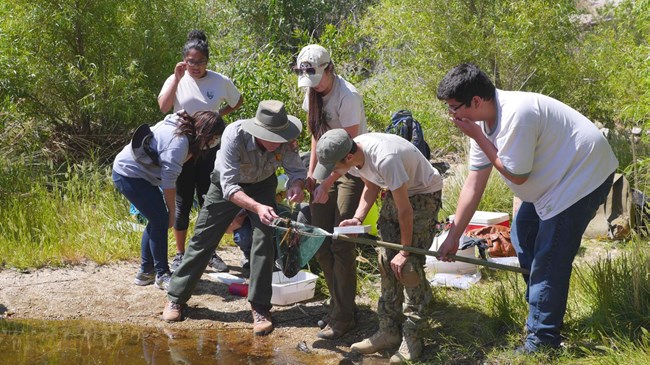Last updated: May 13, 2021
Article
Dragonfly Mercury Project and Citizen Science
Citizen science is when members of the public participate in the scientific process through collaboration with scientists and organizations. This is one case study demonstrating the value of citizen science in helping the National Park Service to meet its mission.
Case Study Overview
The Dragonfly Mercury Project encourages students and visitors in national parks to collect dragonfly larvae for mercury analyses. Mercury (Hg) is a globally distributed contaminant that can harm human and wildlife health. Mercury threatens natural resources the National Park Service is charged with protecting. Dragonfly larvae could serve as indicators of ecosystem health by characterizing the risk and potential toxic effects of mercury.

NPS photo.
Project Description
The Dragonfly Mercury Project began collecting dragonfly larvae from national parks for mercury analysis started in 2011 and expanded each year. In 2017, citizen scientists collected 1,840 dragonfly larvae from 127 sites in 56 NPS units and National Natural Landmarks. In 2018, the project continues by sampling some new parks and supporting the resampling of some parks that have already participated. Citizen scientists include students ranging from elementary school to college-aged, park visitors, and BioBlitz participants.
Project members collect larvae at three bodies of water per park when available. They record site qualities on field record sheets and on iNaturalist.org. Larvae are collected using nets and temporarily stored in a small tote or dishpan with lake water until being sorted. Once at least 10 larvae, ideally 15, have been collected, samples are sorted, and up to 15 individuals are selected for mercury analysis. These are measured, identified to family, then individually bagged to prevent contamination. Specimen identifications and photographs, if taken, are also recorded in iNaturalist. Specimen are then shipped to the USGS Forest and Rangeland Ecosystem Science Center for mercury analysis. Both iNaturalist data and published mercury analysis data is available for public use.
Challenges
Effective training, data quality control, and the impact of the project on dragonfly larvae are challenges for the study.
Some citizen scientists may not have formal training in field survey safety and species identification. The project provides step-by-step field procedures, including safety protocols, and reference sources for species identification. The project encourages participants to perform identification to their comfort level, with the assurance that lab staff will double-check data.
The project’s impact on dragonfly populations was also considered. The project samples the smallest number of individuals that are statistically meaningful. In addition, effects were mediated by dragonflies’ high reproduction rates.
Benefits and Outcomes
The Dragonfly Mercury Project (DMP) connects people to parks, advances the NPS educational mission, fosters biodiversity discovery opportunities, and provides baseline data to better understand the spatial distribution of mercury contamination in national parks. The DMP expands the geographic scope of research previously conducted by scientists and citizen scientists, and provides data that can be compared across parks. Early data are being used to develop hypotheses regarding whether mercury varies with odonate larval body size or by family, or whether a site’s landscape setting drives variability in mercury in odonate larvae. Educational content and lesson plans for use by teachers and NPS staff are also available, ultimately helping to raise awareness about mercury impacts. The DMP enlightens a new generation of citizen scientists about the connection of all living things and the influence humans have upon natural systems, and how environmentally-responsible decisions can protect our parks and the planet.
Tips
The Dragonfly Mercury Project case study illustrates the following steps in the Federal Citizen Science and Crowdsourcing Toolkit:
- Scope Your Problem—Engage Your Stakeholders and Participants: The DMP provides research resources for participants who do not possess formal training in species identification. It also relies on the specialized testing provided by the USGS.
- Design a Project—Know Your Objectives: The project used power analyses to optimize the number of needed samples. It utilizes both field notes and the online database iNaturalist. This program is user-friendly and does not require specialized training.
- Manage Your Data—Share Your Data: iNaturalist allows quick data collection and sharing. Participants are encouraged to utilize results. The USGS and the University of Maine also provide annual result interpretation through webinars and other outlets.
For More Information and Contacts
e-mail us with any questions!
Project Webpage: Dragonfly Mercury Project
Facebook: Six-Legged Scouts in the National Parks
Instagram: #dragonflymercuryproject
Colleen Flanagan Pritz, Ecologist, NPS-ARD
Email: colleen_flanagan_pritz@nps.gov
Collin Eagles-Smith, Supervisory Research Ecologist, USGS-FRESC
Email: ceagles-smith@usgs.gov
Sarah J. Nelson, Director of Research, Appalachian Mountain Club
Email: snelson@outdoors.org
